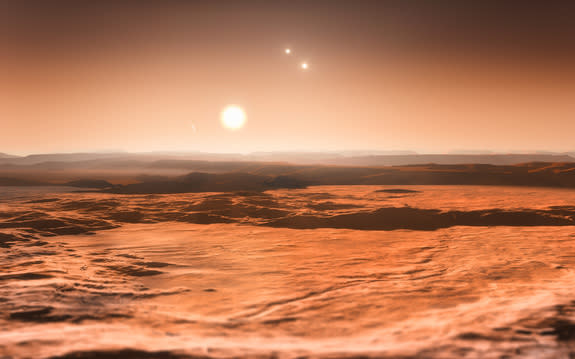 Science and Weather
Science and WeatherNearby star breaks the bank with three planets that could have alien life

It was just around four years ago that astronomers first detected the signs of a planet orbiting around a little red dwarf star, about 22 light years away, in the constellation Scorpius, and my, how these star systems grow up so fast... now we know it has at least six and three of them are potentially habitable!
In 2009, astronomers announced that they'd found one planet orbiting around the star Gliese 667C. It was a scorching hot 'super-Earth', that they named Gliese 667Cb, which was about twice the size of our planet and orbited around its star in just seven of our days. Then, about two years later, more news, when another planet was found there — Gliese 667Cc, which soon rocketed to the top of the Planetary Habitability Laboratory's 'Earth Similarity Index' (ESI)— a rating of how Earth-like another planet is, based on size, temperature, orbit, etc, that goes from 0 (not like Earth at all) to 1 (Earth or its twin). A planet like Mars, our closest best chance for colonizing off-world, only ranks as 0.66, but Gliese 667Cc came in at an astounding 0.82!
[ Related: New project will send your messages to distant alien worlds ]
That was just the start, though, because astronomers have been taking an extra-close look at this system, and just yesterday, that little red dwarf star officially graduated from having just two planets, with one of them potentially-habitable, to having at least six planets (possibly 7), with three of them potentially-habitable.
All three of these planets are so-called 'super-Earths', just like Gliese 667Cb, but all three orbit within the star's habitable zone — that 'Goldilocks' zone where conditions aren't too hot or too cold, so that there can be liquid water on the surface of a planet.
Gliese 667Cc is, currently, still considered the most habitable of the three. It orbits towards the inner edge of the star's habitable zone, taking about 28 of our days to go around its star. It's a little under twice the size of Earth, so if it's a rocky world with oceans, it should have a dense atmosphere (possibly dense enough that it would be hard for us to breathe there).
Gliese 667Cf is the next planet out from the star. It orbits towards the middle of the habitable zone, orbiting every 39 of our days, and although it receives less solar energy than Earth does, the researchers still think that it's "a prime candidate for habitability," with an ESI of 0.76. This is because of the combination of size, gravity, atmosphere and distance from the Sun. This planet is about one and a half times the size of Earth, so if it's a rocky planet like ours, it will have stronger gravity, and thus it will keep a thicker atmosphere that contains more greenhouse gases than ours normally does. So, even though it receives less solar energy than Earth, with more greenhouse gases in its atmosphere, it will capture more of that energy, and the thick atmosphere will guarantee that it sticks around for a long time, to keep the planet warm.
The third planet is Gliese 667Ce, which orbits roughly equivalent to were Mars is in our Sun's habitable zone, going around its star in just over 62 of our days, and it's also about one and a half times the size of Earth. Even though it's further out, and thus cooler, it would likely have a thick atmosphere like its neighbours, so it still has a habitability rating of about 0.60 (a little less than Mars).
Now, you may have noticed that the lettering seems a bit out-of-order for those three, but that's actually right. The planets in the Gliese 667C star system are, going from closest to farthest from the star... b, (h), c, f, e, d, g. One of them, h, hasn't been confirmed yet, but they think its there.
Planet names start with the suffix 'b' because, technically, the star is 'a' — the first object detected in the system. From there, the planets are named in the order in which they're discovered, simply because it's hard to know how many planets there are in a system right when we first start to detect them. The discoveries tend to trickle-in as astronomers do more studies on a star system, so trying to keep the planets' names in order from nearest to farthest would mean constantly shifting the names around, and that's just a confusing problem waiting to happen.
[ More Geekquinox: ‘Roller-coaster’ jet stream brings sweltering heat to the Far North ]
These are all incredible finds, and just this one star system having three potentially habitable planets is amazing, however we're still not finding any 'Earths'.
Professor Abel Mendez Torres, Director of the Planetary Habitability Laboratory at the University of Puerto Rico at Arecibo, pointed out over Twitter that we've hit a barrier in these kinds of planet discoveries, writing: "As long as they are super-Earths in the [habitable zone], it will not go over ESI 0.85. We need Earths!"
However, astronomers are always looking, and coming up with newer, more sensitive methods to find smaller planets. If we don't manage to locate a nearly Earth-like planet sometime in the next couple of years with these other methods, the new space telescope TESS (Transiting Exoplanet Survey Satellite) is set to launch in 2017, which will work a bit like the Kepler telescope, but will make an all-sky survey of all nearby stars rather than just concentrating on one small section of the sky.
Given how many planets we've found in just that small region, get ready for a massive boom in discoveries once TESS is in orbit!
Geek out with the latest in science and weather.
Follow @ygeekquinox on Twitter!


